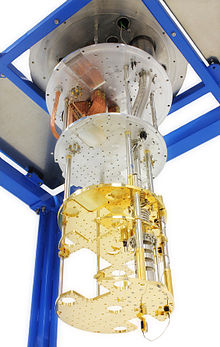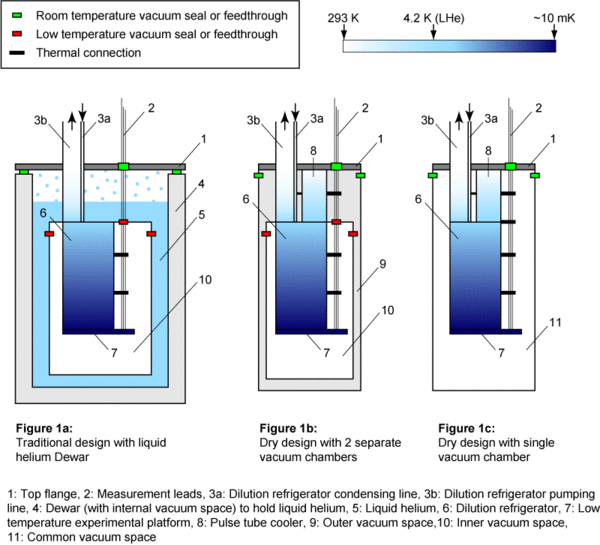- Dry dilution refrigerator
-
A dry (or cryogen-free) dilution refrigerator is a type of dilution refrigerator that does not require the use of any external cryogens, in particular liquid helium, to operate.In the traditional design of a dilution refrigerator (Figure 1a) a liquid helium bath is used. It mainly serves the following purposes:
- It initially precools the unit from room temperature to 4.2 K.
- It acts as a thermal radiation shield.
- It cools the returning incoming 3He and helps to condense it.
In a dry dilution refrigerator a cryocooler is integrated in the design of the refrigerator in order to replace the liquid helium bath (see Figure 1 below). The first experimental machines were built in the 1990s,[1] when (commercial) cryocoolers became available, capable of reaching a temperature lower than that of liquid helium and having sufficient cooling power (on the order of 1 watt at 4.2 K). At present the most commonly used cryocooler is a pulse tube cooler.
The dry dilution refrigerator design shown in Figure 1b is the easiest to realize from an engineering point of view, but not the easiest in operation. The design incorporates an inner vacuum can, which is used to initially precool the machine from room temperature down to the base temperature of the pulse tube cooler (using heat-exchange gas). However, it implies that every time the refrigerator is cooled down, a vacuum seal that holds at cryogenic temperatures needs to be made. It also implies complications (low temperature vacuum feed-through) in the experimental wiring.A design as shown in Figure 1c is possible, but technically more demanding to realize. It requires the use of heat switches, which are necessary for precooling. The heat switches and thermal radiation shields are not shown in the figure. This type of refrigerator is in the SCUBA-2 sub-millimetre camera on the James Clerk Maxwell Telescope.
References
- ^ K. Uhlig and W. Hehn, Cryogenics 37, 279 (1997).
External links
Categories:- Cryogenics
- Cooling technology
Wikimedia Foundation. 2010.


